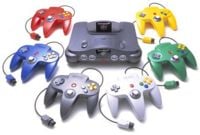Nintendo 64
Template:System-Infobox The Nintendo 64 was a video game console created by Nintendo. It was released in 1996 to compete with the Sega Saturn and PlayStation.
The Nintendo 64 was very popular for many reasons, one of the big ones being the release of Super Mario 64. Super Mario 64 was one of the first games of its kind to feature full 3D graphics and depth of field effects. The Nintendo 64 was able to pull this off because it was the first system to feature a 64-Bit processor and 32-bit graphics chip (aside from the failed Atari Jaguar, which was really 32-bit) The Nintendo 64 also featured the first successful analog control sticks, and four built-in controller ports. The Nintendo 64 was also noted as the last home console system to use cartridges, before Nintendo started using discs like it's competitors.
The Nintendo 64 hosted a wide variety of games, but most of its hits were first-party titles such as Super Mario 64, Super Smash Bros., Mario Kart 64, Mario Party, Paper Mario, Star Fox 64, Legend of Zelda: Ocarina of Time and F-Zero X. Rareware, however, developed quite a few hits for the N64, such as Goldeneye 007, Banjo-Kazooie and Donkey Kong 64. Production ended in 2002. The Nintendo 64 sold 32.93 million units during its lifetime.
In 2003, the so-called iQue Player was released in the Chinese market only, serving as the Chinese equivalent of the Nintendo 64, albeit with a differently designed controller. Its D-Pad and analog stick are placed as on the Nintendo GameCube controller[1]. The entire system only consists of the controller, which has the chip on-board. It has a limited selection of Mario titles, all of which were released for the Nintendo 64 outside China. These include Super Mario 64, Mario Kart 64, Paper Mario, Yoshi's Story, Dr. Mario 64 and Super Smash Bros.
The Nintendo 64 has made a few appearances in Mario games as an easter egg. A Nintendo 64 appears in Super Smash Bros. Melee in the background of the stand where all of the player's trophies are. Francis, from Super Paper Mario also owns a Nintendo 64 as well as a Nintendo GameCube, Virtual Boy and Wii. In Super Smash Bros. Brawl, one of the names that can appear whenever a player presses the random button when they're naming their custom stage is N64, which is a reference to the old system.
The Nintendo 64 (ニンテンドウ64, Nintendō Rokujūyon?, NINTENDO64), often abbreviated as N64, is Nintendo's third home video game console for the international market. Named for its 64-bit CPU, it was released in June 1996 in Japan, September 1996 in North America, March 1997 in Europe and Australia, September 1997 in France and December 1997 in Brazil. It is Nintendo's last home console to use Game Paks to store games (Nintendo switched to a MiniDVD-based format for the Nintendo GameCube, then to standard DVD-sized discs for the Wii); handhelds in the Game Boy line, however, continued to use Game Paks. It was discontinued in 2001 in Japan, North America and PAL regions by the launch of the GameCube.
The N64 was released with two launch games, Super Mario 64 and Pilotwings 64, and a third in Japan, Saikyō Habu Shōgi. The N64's suggested retail price was US$199 at its launch and it was later marketed with the slogan "Get N, or get Out!". The N64 sold 32.93 million units worldwide. The console was released in at least eight variants with different colors and sizes. An assortment of limited edition controllers were sold or used as contest prizes during the N64's lifespan.
Of the consoles in the fifth generation, the Nintendo 64 was the last contender and the most technologically advanced. However the console's storage medium had limitations which harmed the market competitiveness. A significant limitation was the small capacity and high production expense of cartridge-based media instead of the Compact Disc format used by competitors. The limited capacity forced game designers to struggle with fitting game content into a constrained space, though the faster access time of the cartridge medium offered other advantages over Compact Disc media. Another technical drawback was a limited texture cache, which could only hold textures of small dimensions and reduced color depth, which had to be stretched to cover larger in-game surfaces.
Contents [hide] 1 History 1.1 Sales 2 Hardware 2.1 Central processing unit 2.2 Reality Co-Processor 2.2.1 Two of the SGI microcodes 2.3 Memory 2.4 Video 2.5 Hardware color variations 2.6 Accessories 3 Programming difficulties 4 Cartridges 4.1 Games 4.2 Graphics 4.3 Production 4.4 Cartridge-copy counter-measures 5 Emulation 6 References 7 External links
History
The Nintendo 64 owes its existence to Silicon Graphics (SGI) and MIPS Technologies, who were responsible for the R4300i microprocessor and the 3D graphics hardware used in the N64. SGI had recently acquired MIPS Computer Systems, and the two worked together to create a low-cost real-time 3D graphics system. The SGI project was originally offered to Thomas Kalinske, then CEO of Sega of America, by James H. Clark, founder of Silicon Graphics. Sega of Japan's evaluation of the early prototype uncovered several unresolved hardware-issues and deficiencies. They were subsequently resolved; but not before Sega had already decided against SGI's design.
Gallery
- MG64.PNG
- Nintendo 64-mario kart 64.jpg
- MP1 Cover.png
- MP2BOX.PNG
- MP3BOX.PNG
- MT64.PNG
- Papermario.jpg
- 260px-Super Mario 64 box cover.jpg
- SuperSmashBros.JPG
- YS Cover.jpg




